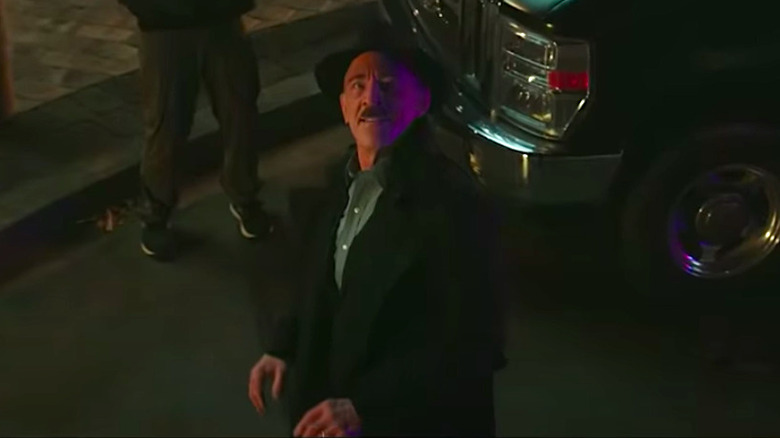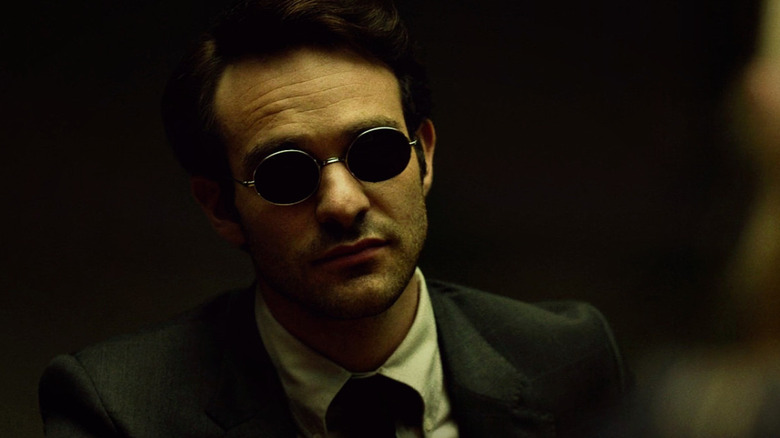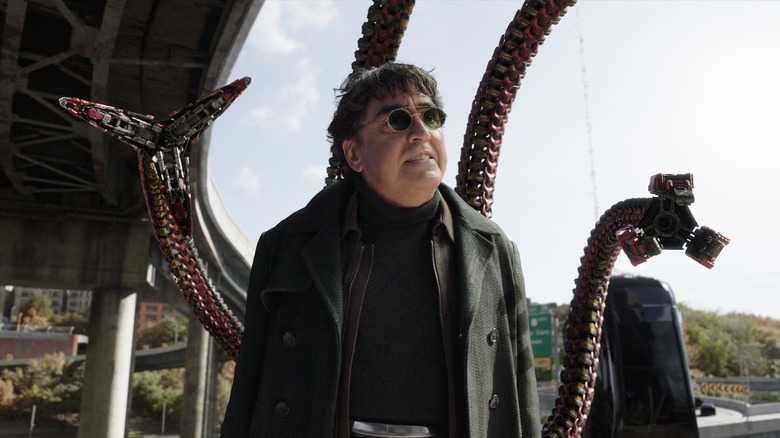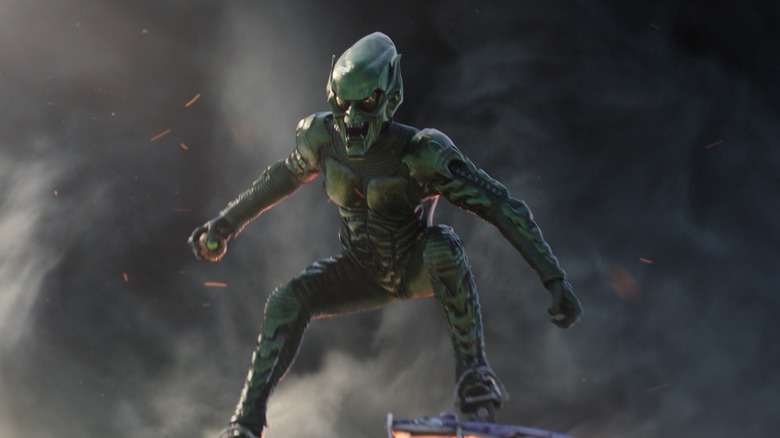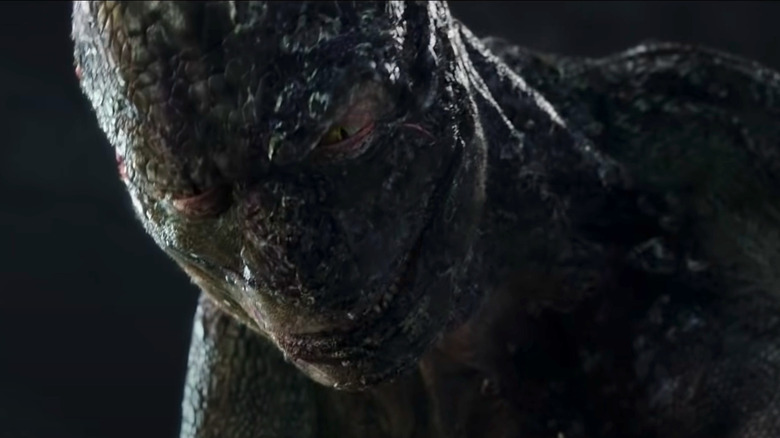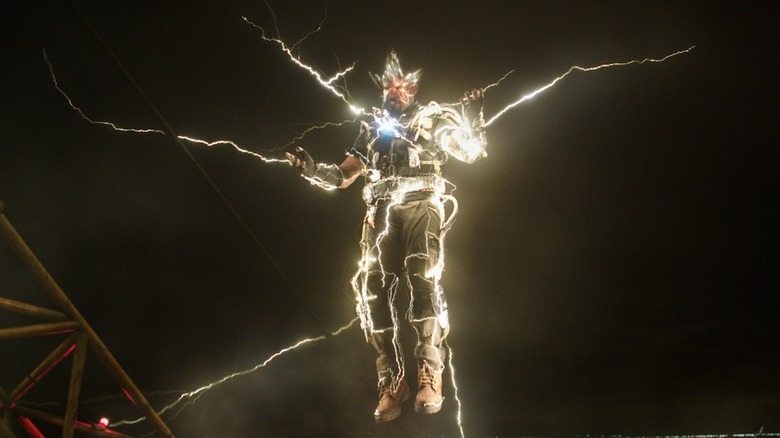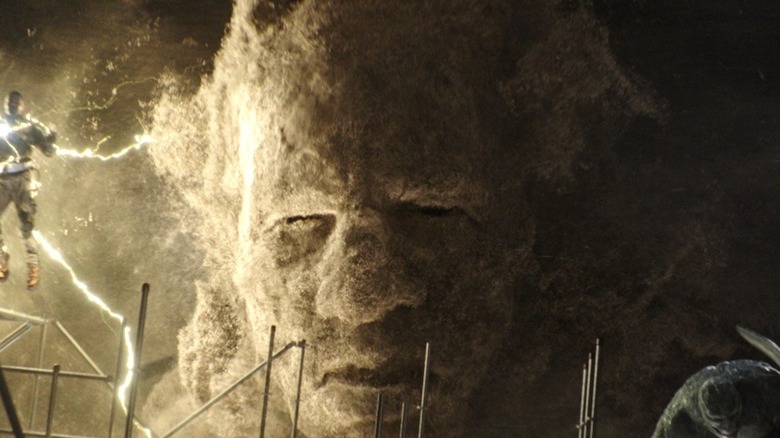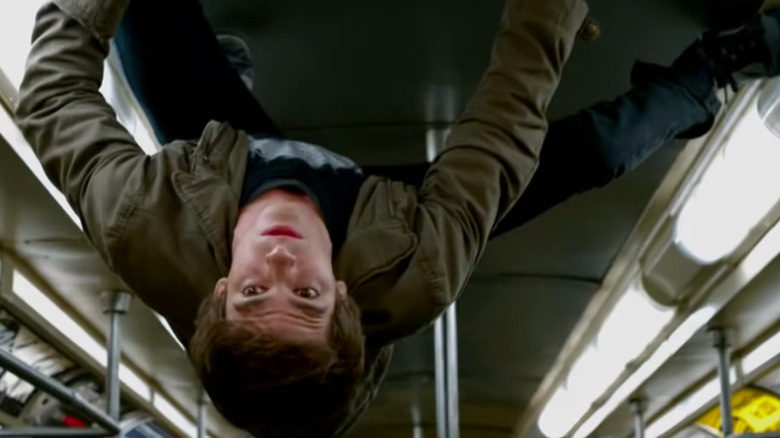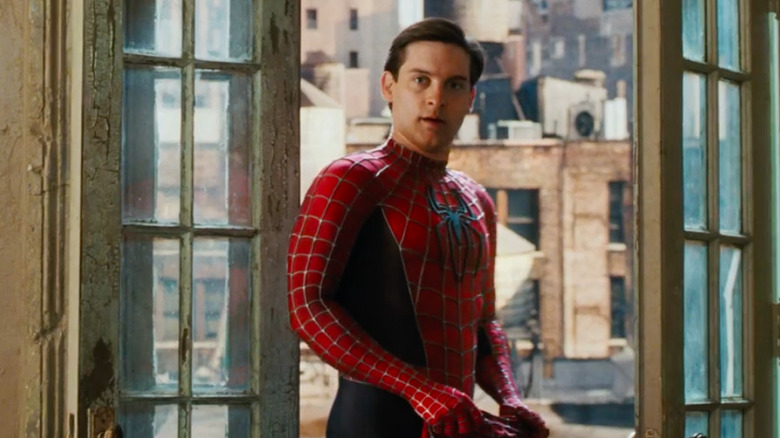Every Non-MCU Character In Spider-Man: No Way Home
The following article contains major spoilers for "Spider-Man: No Way Home."
Rumors have swirled for months about all the non-Marvel Cinematic Universe characters who would appear in "Spider-Man: No Way Home," the third film in the MCU's "Spider-Man" trilogy. So when trailers promoting the film were finally released, it came as no surprise that they revealed several major villains from the past "Spider-Man" series directed by Sam Raimi and Marc Webb who would appear in the new film.
"No Way Home" serves as the big-screen introduction of the MCU's multiverse –- an idea already teased in "Spider-Man: Far From Home" and explored in the Disney+ series "Loki" and "What If...?" However, the franchise uses the newest "Spider-Man" outing to delve into the multiverse in truly spectacular fashion. After Spider-Man's identity as Peter Parker (Tom Holland) is revealed to the world, Peter asks Doctor Strange (Benedict Cumberbatch) to use magic to make everyone forget his secret identity. When the spell goes wrong, it opens a rift between dimensions that lets in several non-MCU "Spider-Man" characters.
This is key to the plot of "Spider-Man: No Way Home," as Peter races to stop those who have entered his reality from causing the same havoc in the MCU that they once caused in their own worlds. The film is an action-packed Spidey mash-up that brings plenty of pre-existing characters to the Marvel franchise — even though most of them don't belong there. Here is every non-MCU character in "Spider-Man: No Way Home."
J. Jonah Jameson
It's true, J.K. Simmons' J. Jonah Jameson was introduced into the MCU at the end of "Spider-Man: Far From Home." However, it bears repeating that this isn't Simmons' first time portraying the character. He originated the role in Sam Raimi's "Spider-Man" in 2002 and reprised it in "Spider-Man 2" and "Spider-Man 3." As far as we know, though, the MCU's version of Jameson isn't a visitor from the multiverse. Despite sharing many similarities, including Simmons' face, an abrasive manner, and a penchant for reporting, the two Jamesons appear to be different people.
Consider that the J. Jonah Jameson in Raimi's trilogy is the editor-in-chief of "The Daily Bugle." He hates Spider-Man and attempts to prove the superhero is really a villain. Nonetheless, he runs a legitimate newspaper. Meanwhile, the MCU's J. Jonah Jameson is more of a conspiracy theorist in the vein of Alex Jones. His style is still bombastic, but now he uses his brusque delivery to make sensational claims through his website, TheDailyBugle.net.
He still hates Spider-Man, though, and this Jameson achieves something the Raimi version never did — turning at least part of the world against Spider-Man. He does this by showing a doctored video of him staging the attack on London from "Far From Home" and killing the villainous Mysterio (Jake Gyllenhaal). Will the MCU ever address why these characters share a face? It's doubtful. Still, it's fun to have Simmons bring his caustic interpretation of the character to the franchise.
Matt Murdock
Fans of Netflix's Marvel shows have been hoping that some of the characters from the various canceled series would show up in the MCU, and it is finally happening. First, the Disney+ series "Hawkeye" gave us a brief, tantalizing glimpse of the "Daredevil" villain Kingpin (Vincent D'Onofrio), and now his heroic counterpart Matt Murdock (Charlie Cox) has made his MCU debut in "Spider-Man: No Way Home."
The film found the perfect excuse to introduce Murdock, as he isn't just a vigilante superhero. He's also a defense attorney in New York City who often takes on difficult cases. After law enforcement officials learn Spider-Man's true identity, they show up to take in Peter, Aunt May (Marisa Tomei), and any other Spider-Man associates for questioning. This leads Aunt May to hire Murdock in order to keep Peter out of jail.
Although he doesn't suit up as his Daredevil alter-ego, Murdock has one superheroic moment. When someone throws a brick through the Parkers' window during a consultation, Murdock catches it before Peter can, surprising and impressing everyone. In explanation, Murdock simply notes that he's "a really good lawyer," keeping his superhero identity under wraps despite being fully aware of Peter's. It's a brief appearance, but hopefully it hints at bigger things to come for the character now that both he and Kingpin are part of the MCU canon.
Doc Ock
Before the MCU introduced its version of Spider-Man, there were five other live-action films featuring the hero. "Spider-Man: No Way Home" introduces one villain from each of them. However, fans are likely to be most excited to see Doc Ock, aka Dr. Otto Octavius (Alfred Molina), often considered one of Spider-Man's best villains. The character is one of the reasons Raimi's "Spider-Man 2" from 2004 is regularly pointed to as one of the best superhero movies ever made. Molina doesn't miss a beat reinhabiting the role, bringing the same cool delivery and raw intelligence to the character as he did almost 20 years ago.
In "No Way Home," Doc Ock is torn from his reality just seconds before he dies. When he arrives on a highway and encounters Spider-Man, he quickly picks a fight with the web-slinger. The tentacles fused to his back make Doc Ock a worthy opponent for Spider-Man, and ultimately it's Peter's access to Stark technology, not his slick superhero moves, that enable him to subdue the newcomer.
One reason Doc Ock is so popular is that, in many ways, he's more anti-hero than a pure villain, as he is a man whose single-minded pursuit of scientific advancement leads to his downfall. "No Way Home" uses that aspect of the character to offer another nuanced depiction, even as it uses some of the sillier aspects of Doc Ock for comedy –- like Aunt May asking whether he prefers saltwater because, you know, he's an octopus.
Green Goblin
Moments before Spider-Man and Doc Ock are whisked off the highway where they first encounter each other in "Spider-Man: No Way Home," Peter is approached by another villain from a different world — Green Goblin (Willem Dafoe). This villain was introduced in the original 2002 "Spider-Man" as Norman Osborn, the father of Peter's (Tobey Maguire) best friend Harry (James Franco). When Osborn tests a new performance enhancer on himself, the substance turns out to be unstable, and he develops an evil alter-ego.
Of course, there is no Green Goblin in the MCU, so when Peter glimpses him in "No Way Home," he sees a "little green elf." Still, he knows that green elf is up to no good, so when Aunt May calls Peter to report that one of the multiversal newcomers is at the charity where she works, he rushes to her aid only to find a confused Norman Osborn who dreads becoming Green Goblin again. Aunt May encourages Peter to help the downtrodden man, and it's her influence that leads Peter to attempt to cure the villains that have made their way into the MCU's reality.
However, while Aunt May is sympathetic to Norman's plight, she hasn't met the sinister Green Goblin. When the supervillain emerges to protect himself from being eradicated, it leads to an epic showdown. "No Way Home" plays up the Jekyll and Hyde nature of Norman Osborn and Green Goblin, making Green Goblin's evil deeds in "No Way Home" feel especially tragic.
Lizard
Like Norman Osborn in "Spider-Man," Dr. Curt Connors (Rhys Ifans) inadvertently becomes the main antagonist of 2012's "The Amazing Spider-Man" when the Oscorp scientist tests a drug made with lizard DNA on himself. He soon morphs into a huge humanoid reptile and comes to the conclusion that all people should follow his lead as lizards lack humanity's many weaknesses.
Despite his reptilian skills, Lizard is the one villain from another dimension that Peter doesn't have to find and imprison in "Spider-Man: No Way Home." By the time Spider-Man brings down Doc Ock, Doctor Strange has already taken care of Dr. Connors, who's still enamored with the idea of turning all humankind into lizards. He's also the villain who receives the least amount of screen time in the film, perhaps because he is the least memorable villain from a previous movie to appear in "No Way Home."
His minimal presence causes him to come across as the least threatening of the Spider-Man antagonists from other worlds. And in the end, in both the MCU and the world of "The Amazing Spider-Man," Lizard's fate is the same — he's restored to his human form.
Electro
When Electro (Jamie Foxx) arrives in the MCU in "Spider-Man: No Way Home," his first order of business isn't to attack Spider-Man. Instead, he finds himself a nice electrical plant and powers himself up, so when Peter finds him, he's reveling in the current and seems to attack largely because Spider-Man attempts to stop his blissful communion. In fact, Electro doesn't even seem to hold the same vendetta against Spider-Man that he did when he was initially introduced in 2014's "The Amazing Spider-Man 2."
In that movie, Electro was originally Max Dillon, an Oscorp electrical engineer who is ignored by virtually everyone. When Spider-Man saves him one day, Max is thrilled to be acknowledged by someone so powerful and quickly becomes obsessed with the hero. Later, after falling into a tank of electric eels and developing the power to harness electricity, he encounters Spider-Man again and is disappointed to discover the web-slinger doesn't remember him. The betrayal causes Electro to go on a rampage and attempt to kill Spider-Man.
However, in the latest film, Electro seems more interested in the fact that electricity in the MCU makes him especially powerful. Moreover, the character seems to have lost his pathetic demeanor from the previous film. So although "The Amazing Spider-Man 2" and "No Way Home" versions of Electro are supposed to be one and the same, they share few similarities outside of being played by Jamie Foxx and their overcharged love of electricity.
Sandman
While 2007's "Spider-Man 3" is often mocked for Peter Parker's ridiculous dance after going dark, the film still had its moments. Many of the film's best scenes involve Flint Marko (Thomas Haden Church), a small-time crook who falls into a particle accelerator after escaping from prison and is turned into Sandman. When Peter Parker learns that evidence suggests Marko is the one who murdered his Uncle Ben, he seeks Sandman out, supposedly to kill him. Ultimately, however, Marko proves to be a truly sympathetic villain. He expresses deep regret for shooting Uncle Ben and confesses that the only reason he turned to a life of crime was to help his terminally ill daughter Penny.
Given that Spider-Man ultimately forgives him in "Spider-Man 3," perhaps it's no surprise that when he first appears in "Spider-Man: No Way Home," Sandman acts as an ally to the MCU's Peter Parker, teaming up with him to bring down Electro. Yet, when he feels threatened, Sandman quickly turns on the hero, forcing Peter to take him down too. Later, he and Electro bond over the fact that they both became supervillains after inadvertently stumbling into unfortunate places and agree that people really need to watch where they fall. Ultimately, Marko doesn't seem to put up much of a fight when Peter seeks to cure him in "No Way Home," signaling that Marko was never really opposed to putting his Sandman persona to an end.
Andrew Garfield's Spider-Man
Many fans suspected it would happen and, indeed, "Spider-Man: No Way Home" unites all three big-screen versions of Spider-Man. Of the newcomers to the MCU, the first to be introduced is Andrew Garfield's Peter Parker from "The Amazing Spider-Man" movies. MJ (Zendaya) and Ned (Jacob Batalon) find Garfield's Spider-Man after Ned opens a portal with his newfound magical powers while searching for the MCU's version of the character. Still, MJ and Ned aren't convinced Garfield's Peter is the real deal, despite the fact he's wearing a spider-suit, and make him prove he truly possesses the Spidey powers he claims to.
Despite his movies being the least popular of the recent "Spider-Man" installments, Garfield was always charming as Peter Parker, and he still is in "No Way Home." Plus, the film uses Garfield's presence to poke fun at the rather meager list of accomplishments his Spider-Man accumulated during his two movies, leaving Garfield to lament that, unlike Holland's or Maguire's characters, he never got to fight a space alien.
Later, Garfield's status as the lowest Spider-man on the proverbial web is confirmed when, in order to avoid confusion, he's dubbed Peter 3 behind his more experienced counterparts. Nonetheless, Garfield's character is given the opportunity to redeem his greatest failure when he saves MJ from falling to her death, something he was tragically unable to do for his girlfriend, Gwen Stacy (Emma Stone), in his world.
Tobey Maguire's Spider-Man
Like Andrew Garfield's Spider-Man, Tobey Maguire's version of the character is introduced in "Spider-Man: No Way Home" during a sequence where MJ and Ned attempt to find the Peter Parker from their world. Maguire's portrayal of the superhero in Sam Raimi's "Spider-Man" trilogy is still beloved. The fact that he initially appears in the new movie in street clothes and identifies himself as Peter Parker proves to be a delightful way to reintroduce this seemingly unassuming version of the character.
All three Peters eventually bond over their shared experiences as Spider-Man, especially the loss of people they love. Moreover, "No Way Home" addresses the fact that both Garfield and Maguire are older than they were when they initially portrayed the character. The pair frequently discuss their back problems and other aches and pains associated with growing older while still fulfilling their duties as costumed superheroes.
Maguire is given an especially poignant moment in "No Way Home" when his Spider-Man prevents Holland's version from killing the Green Goblin, a choice he pays for when the supervillain stabs him. While it's a shocking moment, it establishes Maguire's character's morality as well as his status as the elder statesmen of this trio of Spider-Men, a position that makes him a role model for Holland's younger web-slinger.

